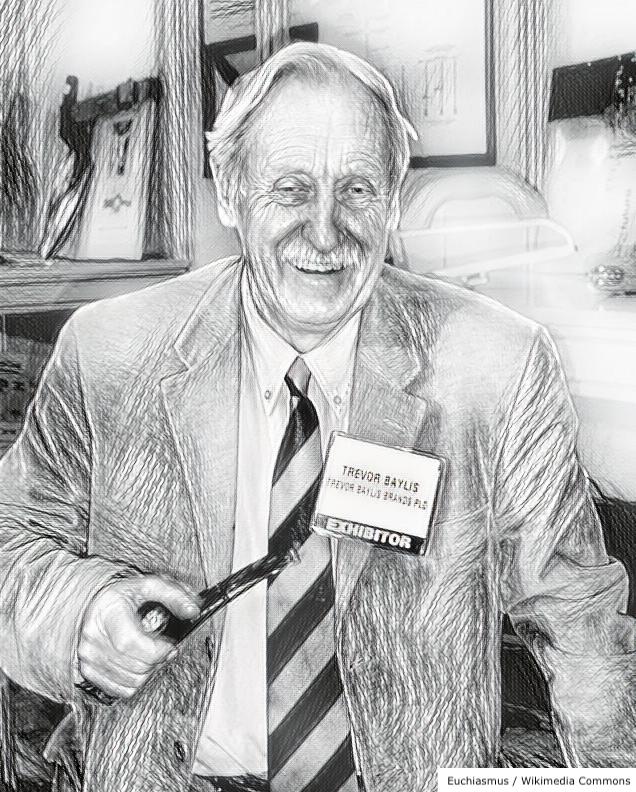Trevor Baylis
Many individuals around the world, particularly in third world countries, lack access to electricity, which makes it difficult for government and non-governmental organizations (NGOs) to pass potentially life-saving information to them in times of crisis or when battling epidemics. Inventor Trevor Baylis came up with a solution to this problem in 1996, when he introduced the world to the first ever hand-powered, wind-up radio.
Born in Kilburn, England, near London, on May 13, 1937, Baylis grew up in Southall, England, where his early education was interrupted by World War II. He was an excellent swimmer who, at the age of 15, was given an opportunity to compete in the sport for England. At age 16, he began working for the Soil Mechanics Laboratory in Southall while studying engineering at a nearby technical college.
Baylis served in the British Army for four years beginning in 1957. In 1961, he accepted a post as a salesman with a swimming pool company, Purley Pools, where he became involved in research and development for the firm. Later he started his own swimming pool company.
Meanwhile, Baylis took on work as a stuntman for television programs in the 1960s and 70s and performed underwater feats in shows such as the Berlin Circus. His experiences led him to launch two spin-off companies, one for aquatic displays and the other for steel swimming pools. The latter, called Shotline Steel Swimming Pools, continues to operate as of this 2007 writing. In addition, having met and worked with so many stunt men who were no longer able to work because of injury, Baylis was inspired to invent a variety of products to aid handicapped people. His line of “Orange Aids” helped people with limited mobility or those who were confined to wheelchairs to hold onto and maneuver objects such as books and utensils more easily.
Baylis was inspired to create his most well-known invention in 1989 when he saw a television program about the spread of AIDS in Africa. Through the show, he learned that in many areas in Africa the only means of mass communication was the radio, but as people often lacked electricity and/or access to batteries, they weren’t able to hear about news and advice that aimed to curb the spread of the disease. He quickly realized that a communication tool that did not rely on external power sources was necessary.
He thought of the old Victorian-era gramophones, which used a hand-crank for power that allowed them to play music. Baylis began experimenting with a small transistor radio, an electric motor taken from a toy car, and a hand brace. He added a clockwork mechanism that allowed a spring to be wound and then to unwind at a controlled pace.

By 1991, Baylis had created a working, wind-up radio that could play for 14 minutes with a two-minute wind. He patented the idea and set out to get the radio into production. At first, interest was lukewarm at best, but in 1994, his prototype was featured on “Tomorrow’s World,” a BBC television program. This was the opportunity Baylis needed. Two enterprising men, Christopher Staines and South African entrepreneur Rory Stear, saw potential in the product right away. They contacted Baylis to express their interest in working with him. Meanwhile, details of Baylis’ wind-up radio were broadcast on a radio station in Johannesburg, South Africa.
Baylis was able to secure funding from Staines and Stear as well as the Liberty Group. This allowed him to set up BayGen Power Industries in Cape Town, South Africa, in 1995. Production of the radios began a year later when consumers were introduced to the “Freeplay” brand wind-up radio. The product was awarded the BBC Design Award for Best Product and Best Design in 1996. Also that year, Baylis was honored with the World World Vision Award for Development Initiative.
Numerous additional honors and awards followed. In 1997, Baylis was awarded the Order of the British Empire and the President's Medal from the UK Institute of Mechanical Engineers. That year, an improved version of the Freeplay Radio made its debut. This smaller, lighter model was designed for the Western consumer market and had a run time of up to one hour with just a thirty-second wind. The Freeplay range later expanded to include flashlights. More recently, the brand teamed with Motorola to create a wind-up mobile phone charger.
Baylis became a much sough-after speaker and media personality. He went on a tour of several African nations lecturing for the British Council in 1998, followed by tours in 2000 to Australia, India, Eastern Europe, and the Middle East. His biography, “Clock This,” was a bestseller. In 2001, he demonstrated another of his inventions, dubbed “Electric Shoes,” by walking 100 miles across the Namib Desert where he raised money for charity and showed off his product, which allows the wearer to use his own walking power to charge a small battery for operating a radio transceiver or cell phone.
In an effort to assist other inventors in protecting their ideas and getting products to market successfully, Baylis established Trevor Baylis Brands in London in 2003. He continues to be active on the public speaking circuit and helps inventors develop and protect their ideas through his company.
Baylis passed away on March 5, 2018.


